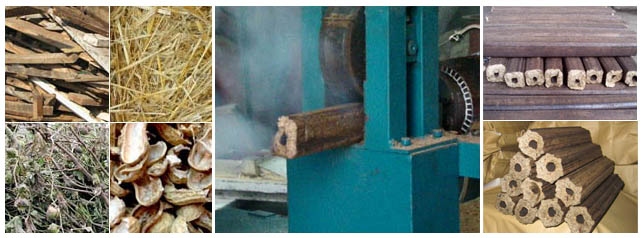How to improve the briquetting performance
A productive biomass briquetting process could make high quality briquette for fuel with high efficiency. Of course, a high quality briquette press is a good start to briquetting solution. But, it’s a complicated process for biomass briquetting. To get success of briquetting, you have to have a good understanding and mastering skill of the whole process.

Biomass residues are uneven in size and bulky in nature, so manual handling in larger operations is labor intensive and cost prohibitive. And, where there are long transport distances and higher elevations, mechanization can even be difficult. In large, integrated biomass processing plants, mechanization is critical and must be incorporated at all stages of the process from harvesting to primary storage, from primary storage to main storage and from main storage to the processing plant. An electrically powered tipper/extractor and a pneumatic conveyor system are more cost effective than diesel-powered equipment. Mechanization reduces processing time and labor costs as well as optimizing space utilization.
For 24/7 operation and high productivity, automation should be incorporated in these key areas:
Process Control:
• Drying: To maintain output moisture of around 15 percent, the temperature of the discharge flue gas should be maintained at 85 degrees C. This can be done by controlling the cold air injection into the hot air from the hot air generator.
• Die Holder Temperature: For smooth production of briquettes, the die holder temperature should be maintained around 300 degrees C by regulating the water flow into the die holder.
• Cooling Oil Temperature: The lubricating oil temperature should be controlled by an automated radiator fan.
• Die Holder Pressure: The die holder pressure is similarly maintained at the desired level.
Process Optimization:
• Grinding: It is difficult to optimize loading of the grinding system, however, traveling bottom bins are effective. The bottom bin speed is adjusted and controlled in proportion to the desired input into the grinder and increases until the maximum grinding load is achieved. On/off controls start functioning at optimum loading.
• Densification Equipment: Controlling the material input flow from the storage bin into the
briquette machine is relatively easy. The input flow increases to maximum load per the load setting on the press.
Other requirements for higher productivity are:
• Wear parts with a minimum life of 200 hours.
• Reversible hammer mill for sustained operation for 150 hours.
• Intermediate storage of the post-grind material to optimize the feed rate to the briquette press.
• Automated controls to maintain constant die holder temperature, briquette head temperature and moisture in ground material, which when optimized delivers nonstop briquettes.
• An inventory of spare parts and replacement wear parts must be maintained to minimize downtimes.
Raw Material: Chances are wood waste/biomass prices are still not established in your region and in many cases it is still a disposal problem. This is always a matter, however, of supply and demand. Check for availability of low-cost raw material in your area.
--------------------------------------------------------------------------------------------
Rice husk is a widely used agro waste for processing agro by-products, even though it seems useless. However, rice husk briquettes are quite useful as a kind of renewable green energy. You can realize biomass briquettes production with Kingman rice husk briquette machine and briquette plant.
